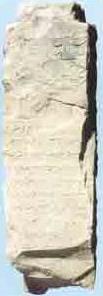Aramaic Stelae, 5th century BCE
The discoveries, a century apart, of two fifth-century B.C. stelae (monuments) inscribed in Aramaic at the oasis of Tayma’ (Biblical Tema) cast light on a time when the Babylonian empire extended deep into the Arabian peninsula. The first stela was uncovered in 1880 and is now in the Louvre; the more recent find, found only in 1980, resides in Saudi Arabia.
For about ten years in the middle of the sixth century B.C., Tayma’ was the residence of Nabuna’id (Nabonidus in the Bible), the last king of the Neo-Babylonian empire. In response to social, religious and economic problems in the empire, Nabonidus left his son Bel-shar-usur (the Belshazzar of the Book of Daniel) in charge of affairs in Babylon, and led an army through Syria and south to Tayma’, conquered the city, executed its king and slaughtered its inhabitants. After repopulating and refounding the city as a kind of capital-in-exile, Nabonidus was able to control the Arabian trade routes, pushing 250 miles further south to Yatrib (later called Medina).
Nabonidus states in various inscriptions that he established garrisons in and planted colonies around six named oases. His own forces are called “the people of Akkad and of Hatti-land”—that is, both native Babylonians and people from the western provinces. Five of these six oases were, at the time of Muhammad a millennium later, Jewish settlements. This suggests that Nabonidus’s troops included a major contingent of Jews, either Jews from Palestine or Jews exiled to Babylonia after the destruction of the Jerusalem Temple in 587 B.C.
In the fragmentary Dead Sea Scroll known as the Prayer of Nabonidus (4QprNab), “Nabunai king of Babylon” gives thanks to the Most High God for curing him of “an evil ulcer [that afflicted him] in Teiman,” perhaps a mistake for Tayma’. Many scholars think the story in the Book of Daniel about Nebuchadnezzar’s seven years of madness (Daniel 4-28–33) is based on Nabonidus’s ten years in Tayma’.
The Aramaic script on the two stelae is similar, dating to about the mid-fifth century B.C. (a century after Nabonidus). One noted scholar prefers a date in the late fifth or early fourth century. These inscriptions provide evidence of a continuing influence of Syrian and Mesopotamian culture in the region long after Nabonidus made Tayma’ his capital-in-exile. This is shown not only by the use of Aramaic language and script, but by the fact that the deities mentioned in the stelae seem to be Syrian or Syro-Mesopotamian.
Three symbols on the recently discovered stela represent the sun, the moon and the morning star. The Aramaic inscription, engraved in relief, reads in part- “…Psgw shdw, son of [M]alky…made an offering in the temple to Salm of Rab…he set up this throne before Salm of Rab as the pedestal of SðNGL’ and SðYM, the gods of Tayma’ for the life of the soul of Psgw shdw and his seed.”
The chief deity in both stelae is S|LM, probably vocalized Salm. He is called S|LM of RB (Rab) in the new text and S|LM of MHRM (Mahram) in the 1880 stela; Rab and Mahram are probably names of important local sanctuaries of Salm. Several other deities are mentioned in both texts. One named SðNGL’, although otherwise unknown, may incorporate the name of the Mesopotamian moon-god SN or Sin (possibly combined with that of Nergal, the god of plague and the underworld). Nabonidus was especially devoted to the moon-god.
A second deity is associated with SðNGL’—‘SðYR’ in the 1880 stela and ‘SðYM’ in the new stela. ‘SðYR’ is probably the well-known Syro-Canaanite goddess Asherah. ‘SðYM’, who appears alongside SðNGL’ in the new stela, must be the goddess Ashima of 2 Kings 17-30, where we are told that she was worshiped in Samaria by Assyrians who came from Hamath.
P. Kyle McCarter, Jr., “Enigmatic Finds- What Are Two Aramaic Stelae Doing in Saudi Arabia?” BAR 21-02, Mar-Apr 1995.




